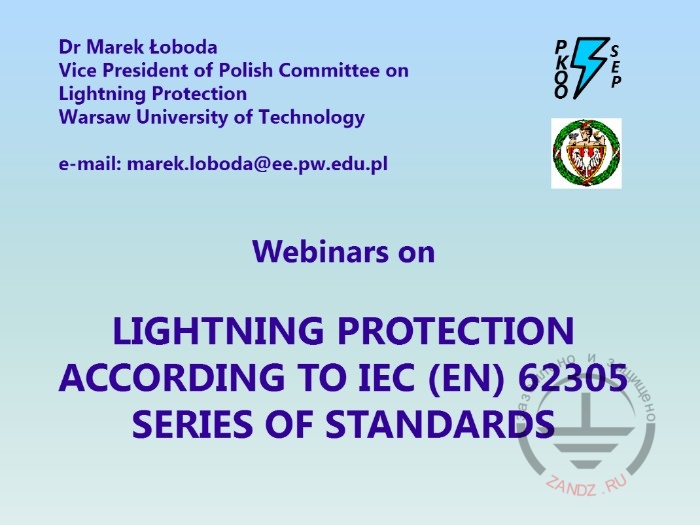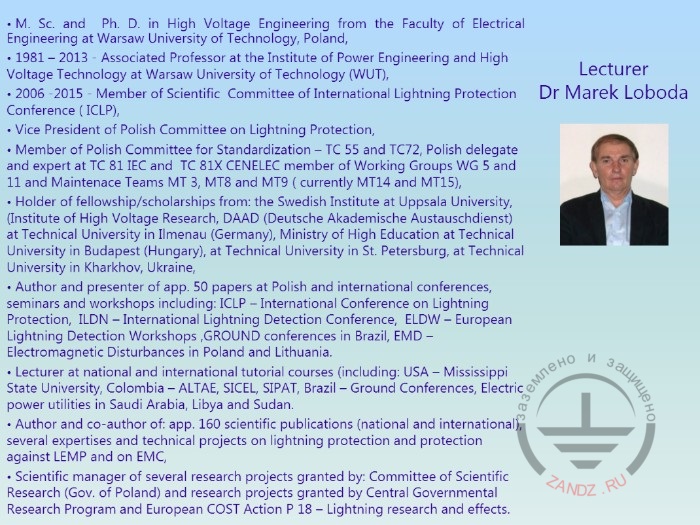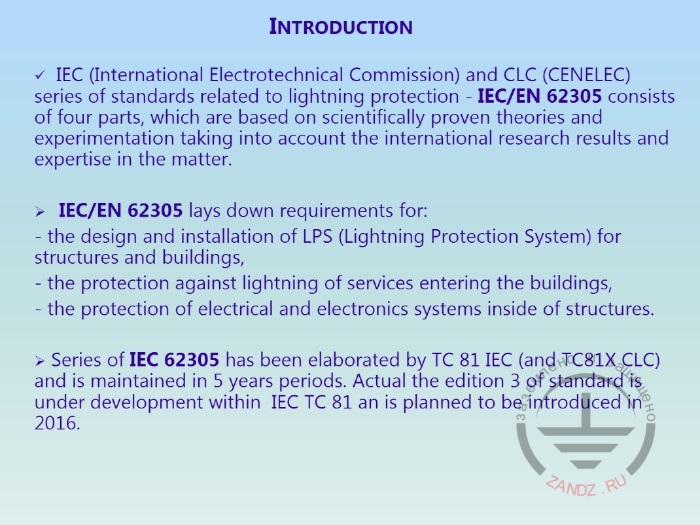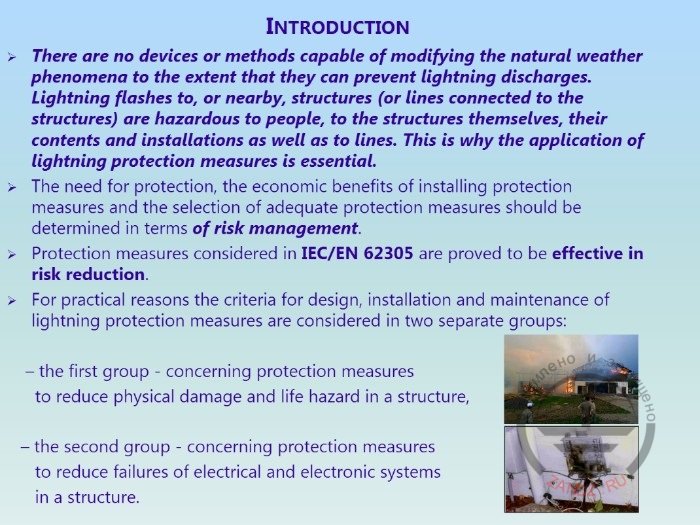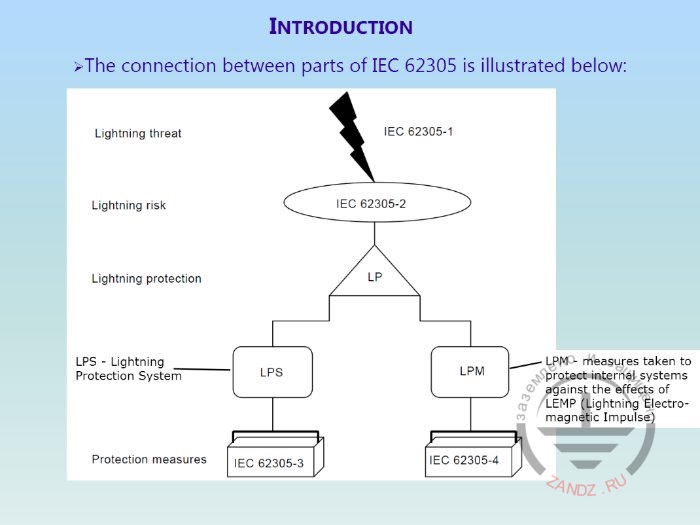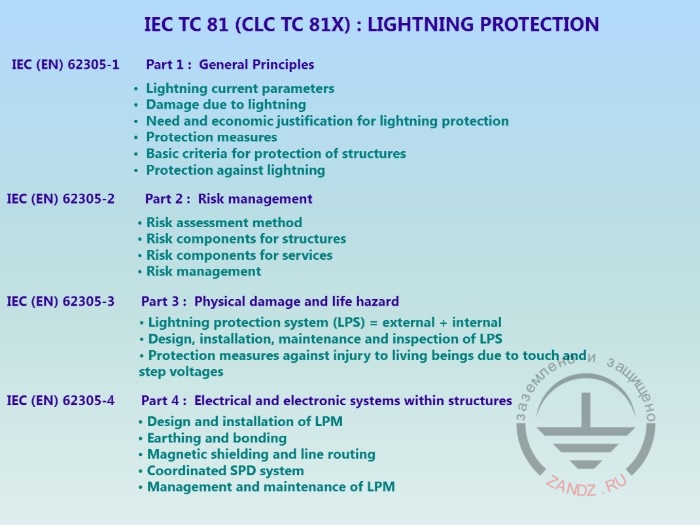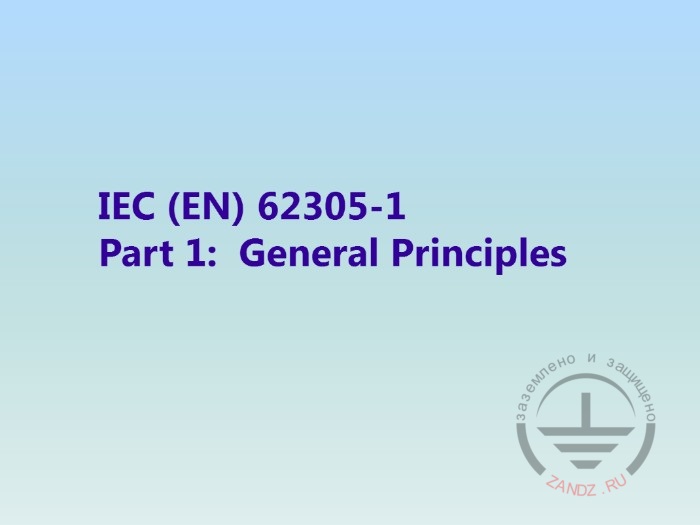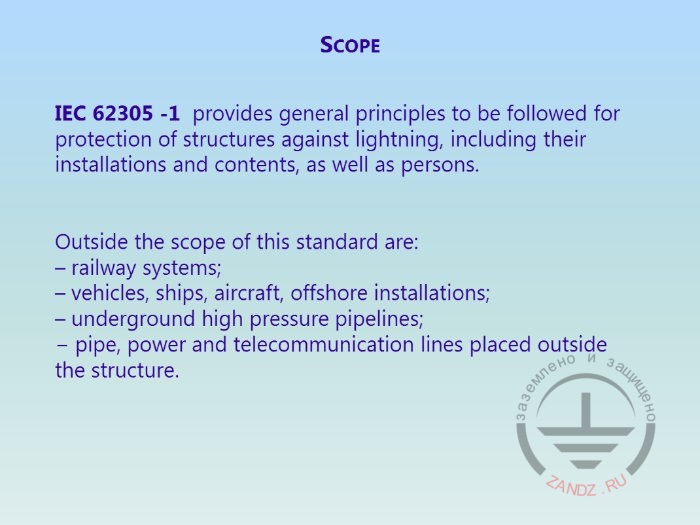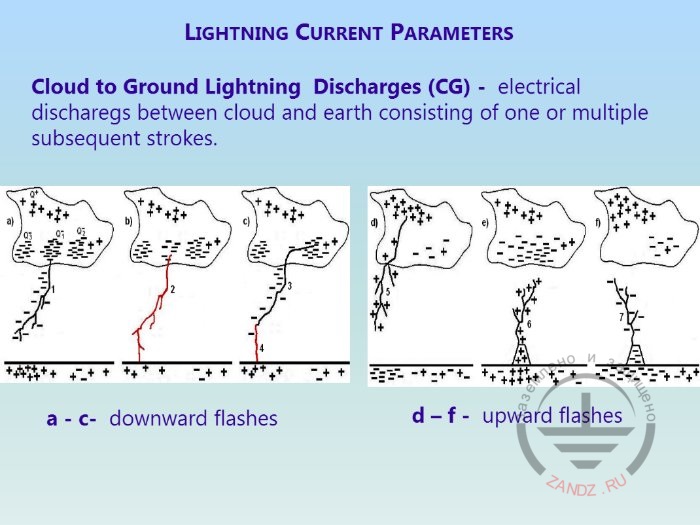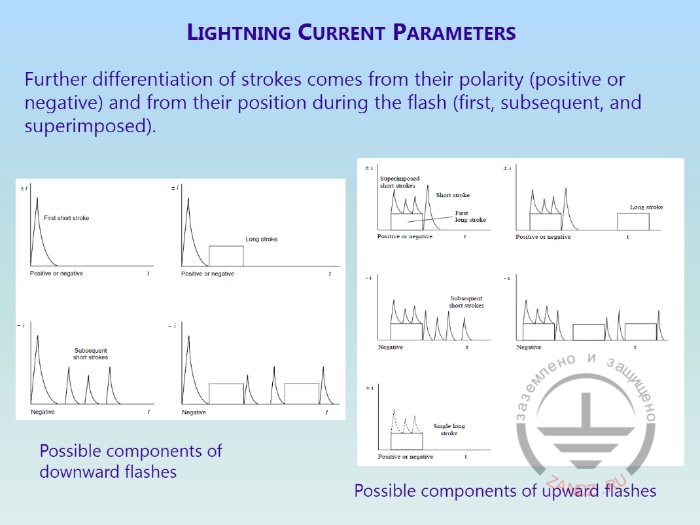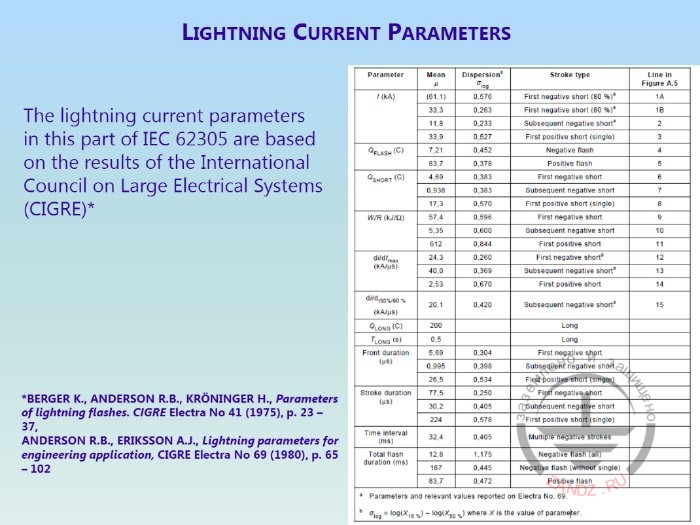The first webinar of a series "Grounding and lightning protection: IEC 62305 standard"
(was held on February 4, 2015 at 11:00 Moscow time)
We recommend watching with the quality of "1080p" in a full-screen mode.
A lightning strike into a building (structure) or near it is a source of danger to life and health of people, the integrity of the building (structure), its internal objects and utilities. Therefore, the development and implementation of protective measures against lightning is a very important task.
Recommendations provided in this standard allow developing effective protection measures to ensure the reduction of the risk of shock resulting from the lightning strike.
The "General Principles" section studies the following issues:
1. The damage that may be caused by the lightning strike depends on a facility and the exact impact point.
The lightning strike into a building (structure) can cause damage directly to the building (structure), injuries and loss of life, as well as damage to property, including failures of internal systems in the building. Damage and failures may occur in the territory in the vicinity of a building (structure) and cover the surrounding area. The scale of destruction escalation depends on the specifications of the building (structure) and lightning strike parameters.
This section describes:
a) the impact of lightning on a building (structure);
b) sources and types of damage to buildings (structures);
c) the types of losses.
2. Economic feasibility and requirements for lightning protection.
To reduce the social losses, the need for the protection of the building (structure) from lightning strikes should be assessed. To assess whether lightning protection is really necessary, the risk assessment is carried out in accordance with the procedures set forth in IEC 62305-2.
3. Safety measures and their choice:
a) measures to protect people against death and serious injuries from electric shock;
b) protective measures to reduce physical damage to the building (structure);
c) protection measures to reduce failures of electrical and electronic systems.
4. Main criteria for the protection of structures.
A perfect protection of a building (structure) supposes that the facility to be protected is grounded, fully shielded with a conductive shield of an appropriate thickness and has an adequate connection at the entry point of communication line shield of the building (structure). Such protection can prevent penetration of the lightning current and its electromagnetic fields into the protected facility and prevent dangerous thermal and electrodynamic effects of current, and consequently the risk of fire and voltage surge in internal systems. However, in practice, it is often impossible and economically unfeasible to ensure the ideal protection.
Dr. Marek Loboda has been a member of the committee for the development of this standard and knows about all the problems faced by lightning protection designers and other professionals working with the regulation at first hand. Join our online meetings to understand the essence of the document and solve all problems related to the implementation of lightning protection systems!
Webinar text. Page 1
Quick navigation through slides:
Page 1:
1. International electrical technical standard IEC 62305
2. Service record of Dr. Marek Loboda
3. Main standard series
4. Risk assessment methods
5. Configuration of IEC standards
6. General topics and parts of the standard
7. Principles of the standard first par
8. Exceptions of IEC standards
9. Descriptions of lightning current parameters
10. Charts of possible lighting components
11. Lightning current parameters
12. Lightning strike impact chart
13. Value of probable current strength
14. First session of questions
15. Damages because of a lightning strike
16. Characteristics of a lightning strike
17. Table of effects from a lightning strike
18. List of possible places of a lightning strike
19. Classification and results of lightning strikes
20. Correlation between types of risks and losses
21. Economic justification of lightning protection. Second session of questions
22. Lightning protection measures
23. LPM — lightning protection measures
24. Main criteria for lightning protection structure
25. Chart of lightning protection levels
26. Chart of lightning protection levels effects
27. Minimal values for lightning protection efficiency estimation
28. Lightning protection zones
29. Description of lightning protection zone LPZ by LPS
30. Description of lightning protection zone LPZ by LPM
31. Protection of constructions part 1
32. Protection of constructions Part 2
33. Questions and answers
Estimated reading time: 44 minutes
— Ladies and Gentlemen, good afternoon!
— Hello, my name is Anastasia and I am the interpreter of the today's webinar. Not looking at the fact that our lecturer professor Marek Loboda perfectly speaks Russian and understands it also well, he will present this presentation in English. I will be interpreting for your convenience. You can adjust the volume to your convenience: either add up volume of Marek and listen to his speech in English or listen to my translation, or even listen to both of us with a different level of volume. You can leave questions in the chat in the Russian language. Marek will be able to read them and answer in Russian, but if he needs my help, I will gladly do it. Enjoy the webinar and I am passing the word to Marek Loboda.
International electrotechnical standard IEC 62305
— Hello everyone! My name is Marek Loboda. I am talking from Warsaw, Poland. Good morning, good afternoon, depending on what part of the country you are in! I am very happy to have this chance to meet you and show you the lightning protection requirements which were developed by the International Electronic Commission. Number of the standard IEC 62305. It contains four standards, which relate to lightning protection measures in relation to buildings.
Service record of Mr. Marek Loboda
— Before starting to talk about standards and requirements, I will tell a few words about myself. As Anastasia has just said, I am the assistant professor of the Warsaw Electric Energy Institute of the Technological University. I am also a member of the committee on standardization TC 55 and TC 72. I am happy to be able to discuss the standards and present the main idea of these standards and even discuss them together on the Internet.
Main series of the standard
— If to start talking about standards, I would like to stop on the main traits of each standard. These standards advance demands to design and installation of lightning protection systems in relation to buildings and structures. They also include lightning strike protection relative the services presented inside these buildings, and also protection of electronic and electric systems inside these buildings. The fourth part of these standards relates to the protection of electronic systems. It is very important, because if there happens a lightning strike near the building, not into the building directly, the consequences can be serious as well, this should be considered. IEC 62305 series of standards was developed by the technical commission 81 IEC. And every 5 years it publishes new standards with some new amendments, corrections and editing. Now we are working on the third publication of these standards and we will have a meeting in Rome in 2 weeks about it. We plan to publish the new IEC standards next year.
Risk assessment methods
— I suppose that each of you has an idea about lightning discharges, about the effects of their impact on buildings and people. We understand that lightning flashes are very dangerous for buildings, people, and systems inside this building. These international standards estimate the risk which may arise due to lightning flashes and reduce this risk gradually. This is called risk management, risk assessment methods. There are general criteria of design, installation and use of lightning protection systems for practical reasons. They are divided into 2 groups. The first group relates to lightning protection measures against damage brought to buildings and people inside these buildings. And the second group relates to lightning protection measures which will help to reduce the failure of electric or electronic systems inside these buildings.
Configuration of IEC standards
— As you know in practice, even in Poland there were very serious destructions due to strong lightning strikes. The main configuration of IEC standards is divided into 4 parts. The first part, which I am going to talk about, characterizes lightning current strength. And the second part relates to lightning strike risk. If you are going to listen to me in the future, then the next webinar will be related to the lightning strikes risk assessment.
General topics and parts of the standard
— Here you see the general topics and parts of this standard. I mean the first one is general principles, and the second - risk assessment methods, including methodology, risk components which depend on the type of building and type of services offered in these buildings. The third part is the most important part for design of lightning protection measures, because it gives fundamental information how to choose lightning protection measures and how to install it, how to use it, how to work with vertical lightning rods, lightning arresters etc. And, finally, the fourth part. To my mind, it is also very important. This use and installation of lightning protection measures, including data lines, computer, television etc. is the protection of electronic and electric systems.
Principles of the first part of the standard
— Before we begin, please allow me to tell you the general principles of the first part which relates to lightning protection.
Exceptions of IEC standards
— It is very interesting to remember that the first part of the standards relates to structures, buildings and also people and the objects inside these buildings. However there are some exceptions, which these IEC standards do not cover in this publication. This standard does not cover railway system; vehicles, water and air transport, as well as offshore installations, high-pressure underground pipes, power transmission line and telecommunications pipelines outside the protected buildings (structures). And these systems should also be protected against lightning, but this topic relates to the other international standards. They are individually studied in every country.
Lightning current parameters description
— In the beginning of the first part, I would like to give the description of lightning current parameters. It is a classification of standards, discharges between the clouds and the ground, which is the main reason of damage to buildings and structures. There are lightning which are directed downwards, when the lightning discharge comes from the cloud in which there is an electronic discharge. Usually the electronic discharge is in the bottom part of the cloud and 90% of such a cloud discharge is a negative discharge when it strikes into some object on the ground.
Charts of possible lightning components
— Here you see the charts in which the possible components of upward and downward lightning are described. On the left - down, on the right -up. Lightning discharges are mainly negative. And very rarely their polarity is positive. As concerns lightning directed upwards, they can be different depending on the type of building's structures.
Lightning current parameters
— That is why, it was decided to divide these lightning strikes to downward and upward. Lightning current parameters which relate to this standard have been developed for many years. It were the scientific researches of the International Counsel on Large Electric Systems - CIGRE. In the bottom you see the names of this research authors.
Next Page >>
Slides from 12 to 22
Useful materials for designers:
- Webinars with the leading industry experts
- Everything for the calculation of grounding and lightning protection
- Useful materials: articles, recommendations, examples
Related Articles:
 External lightning protection. Elements.
External lightning protection. Elements.
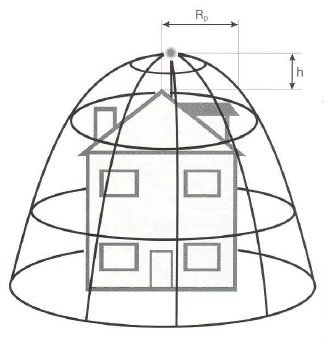 GALACTIVE active lightning rod
GALACTIVE active lightning rod




